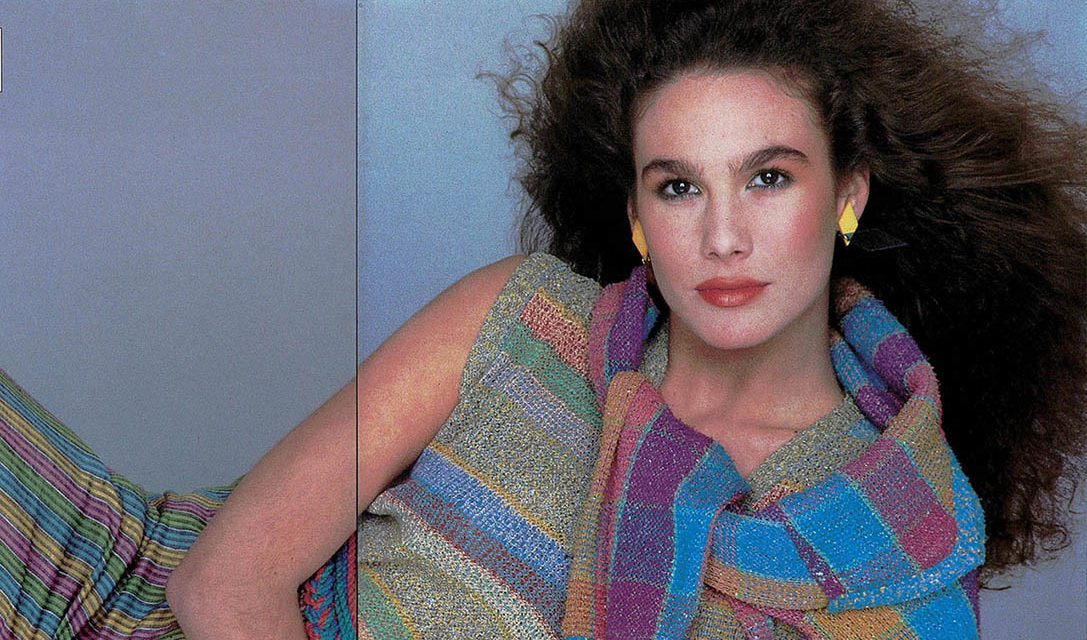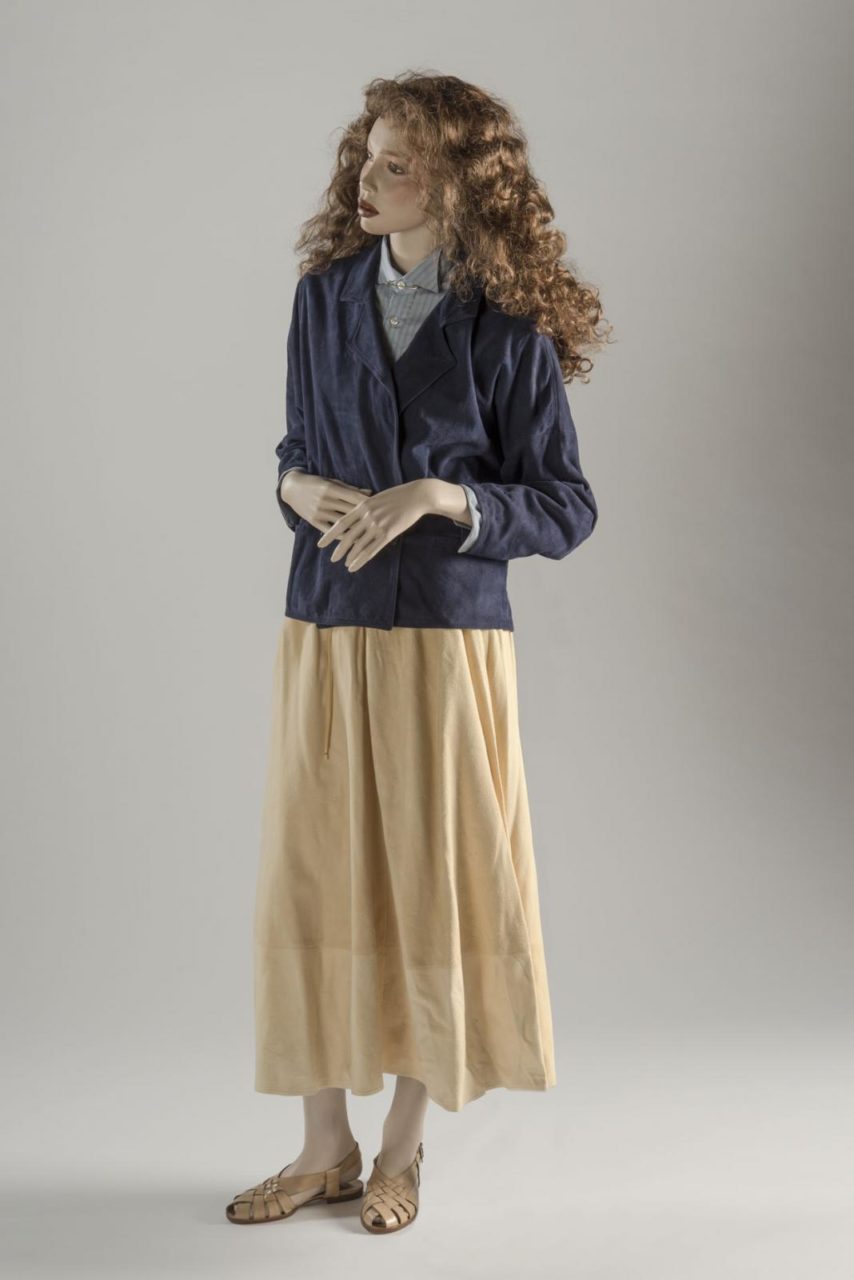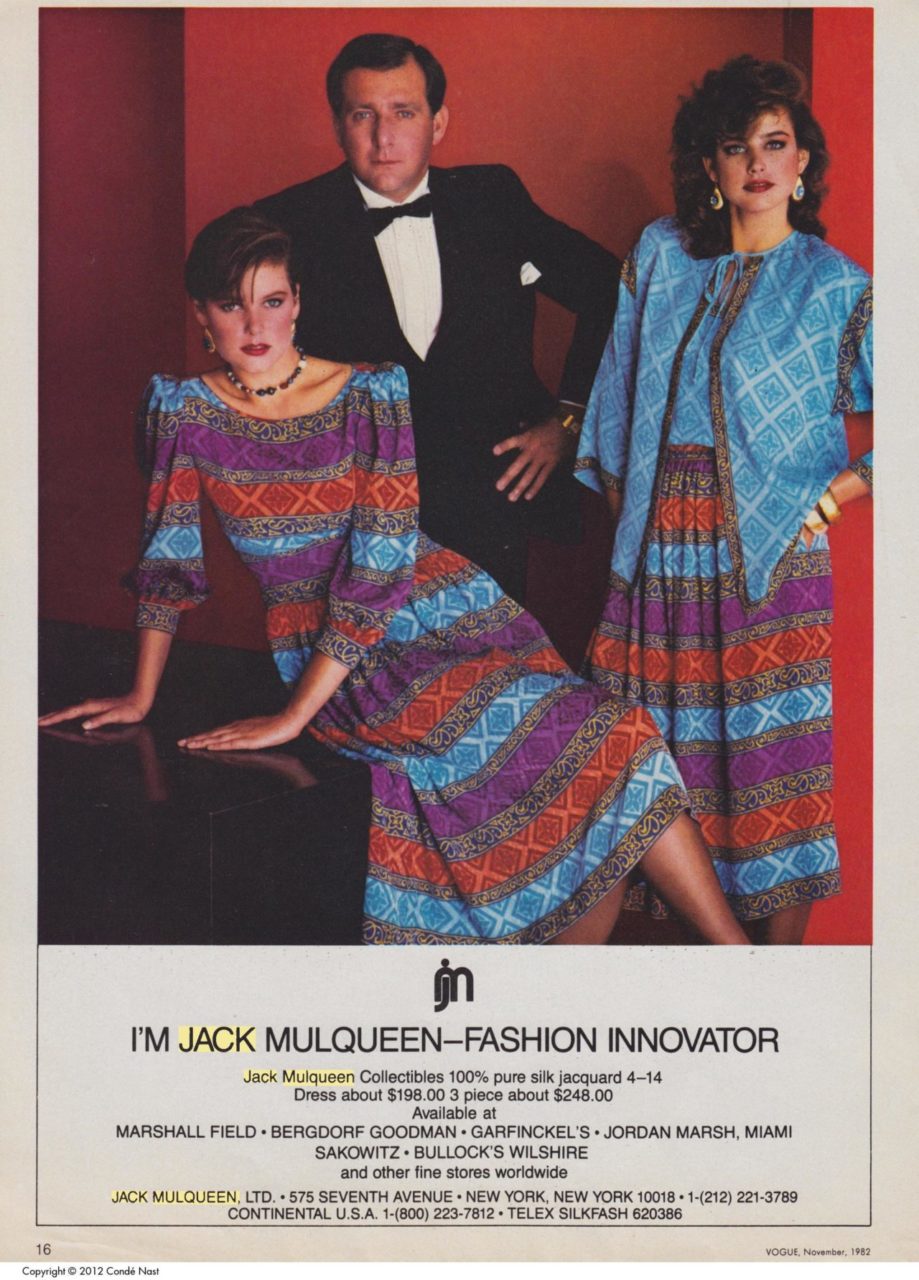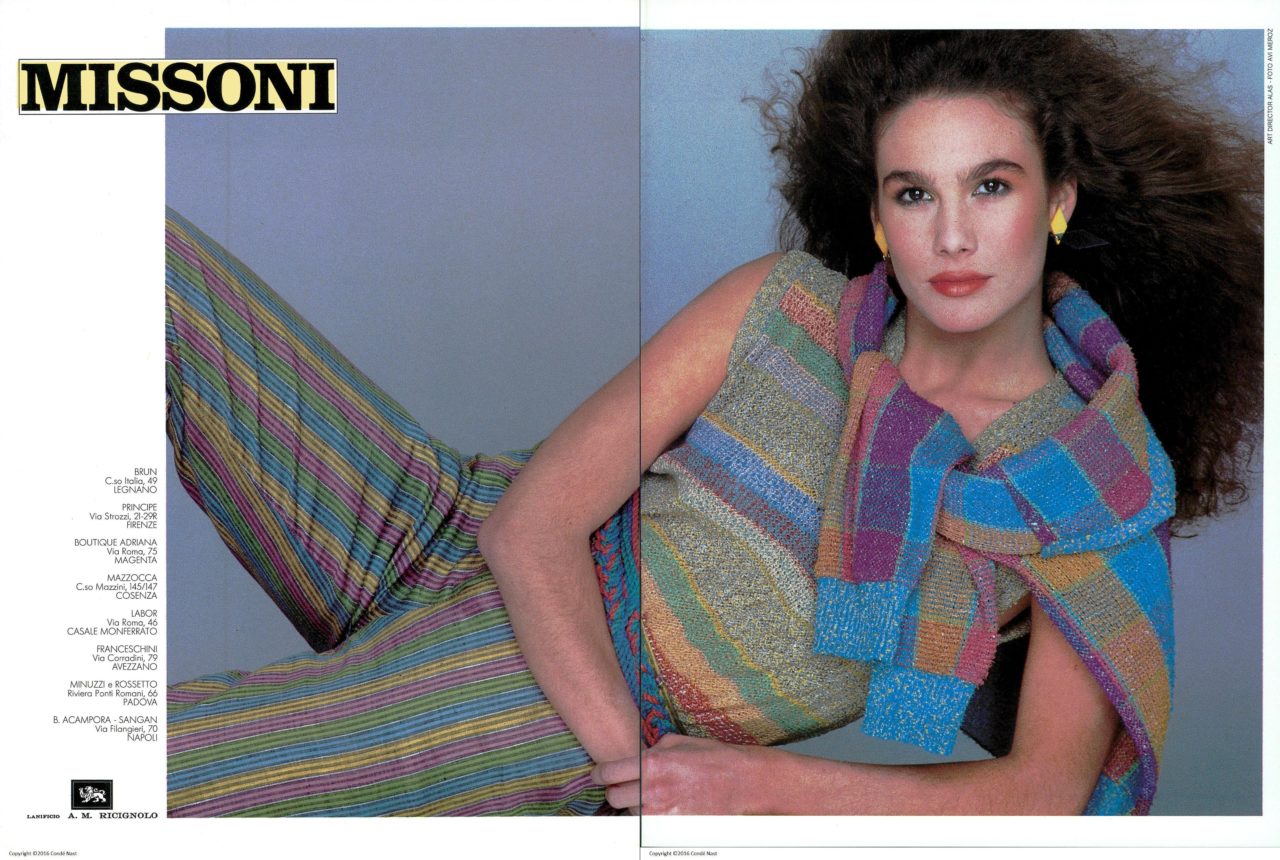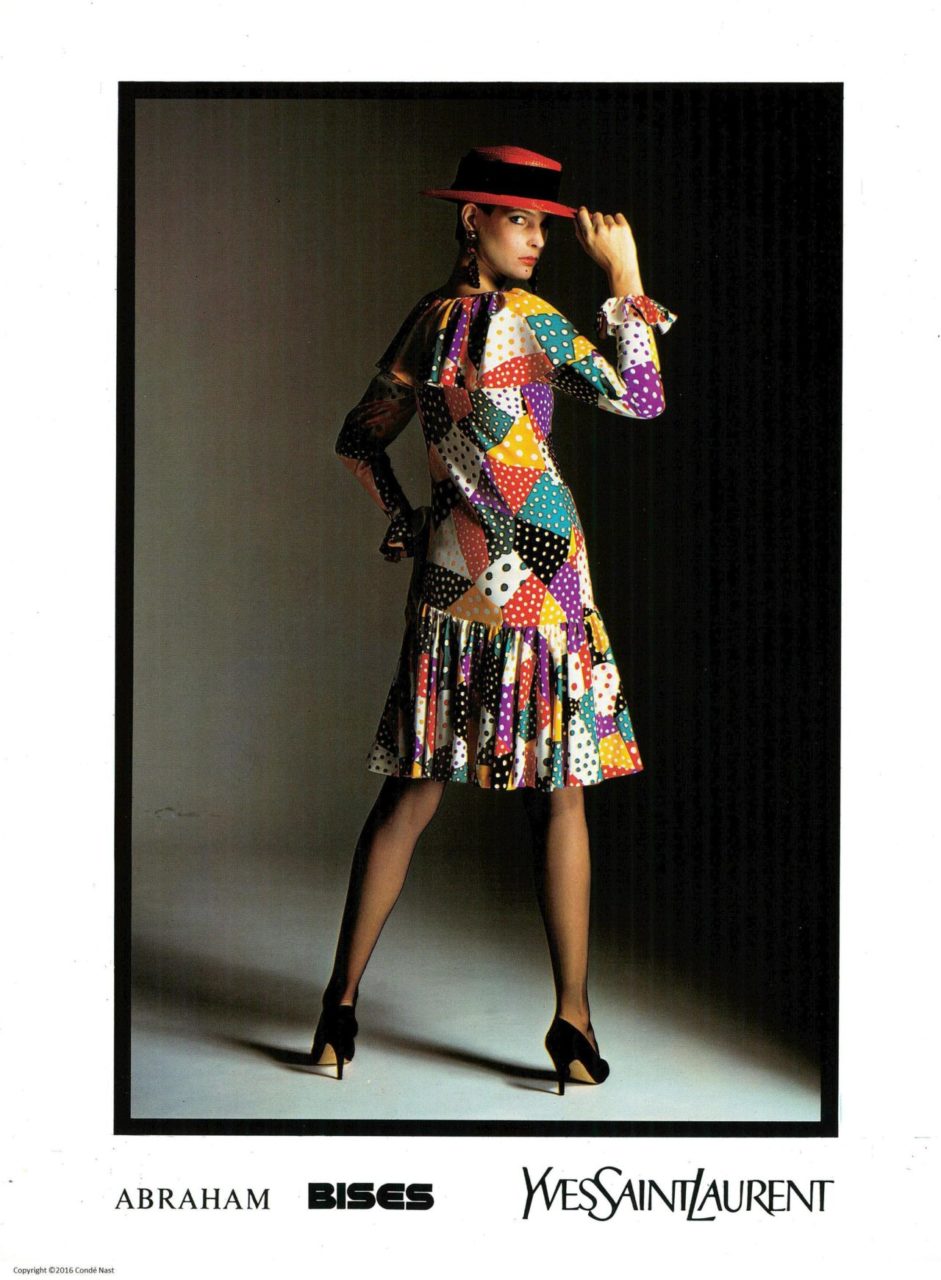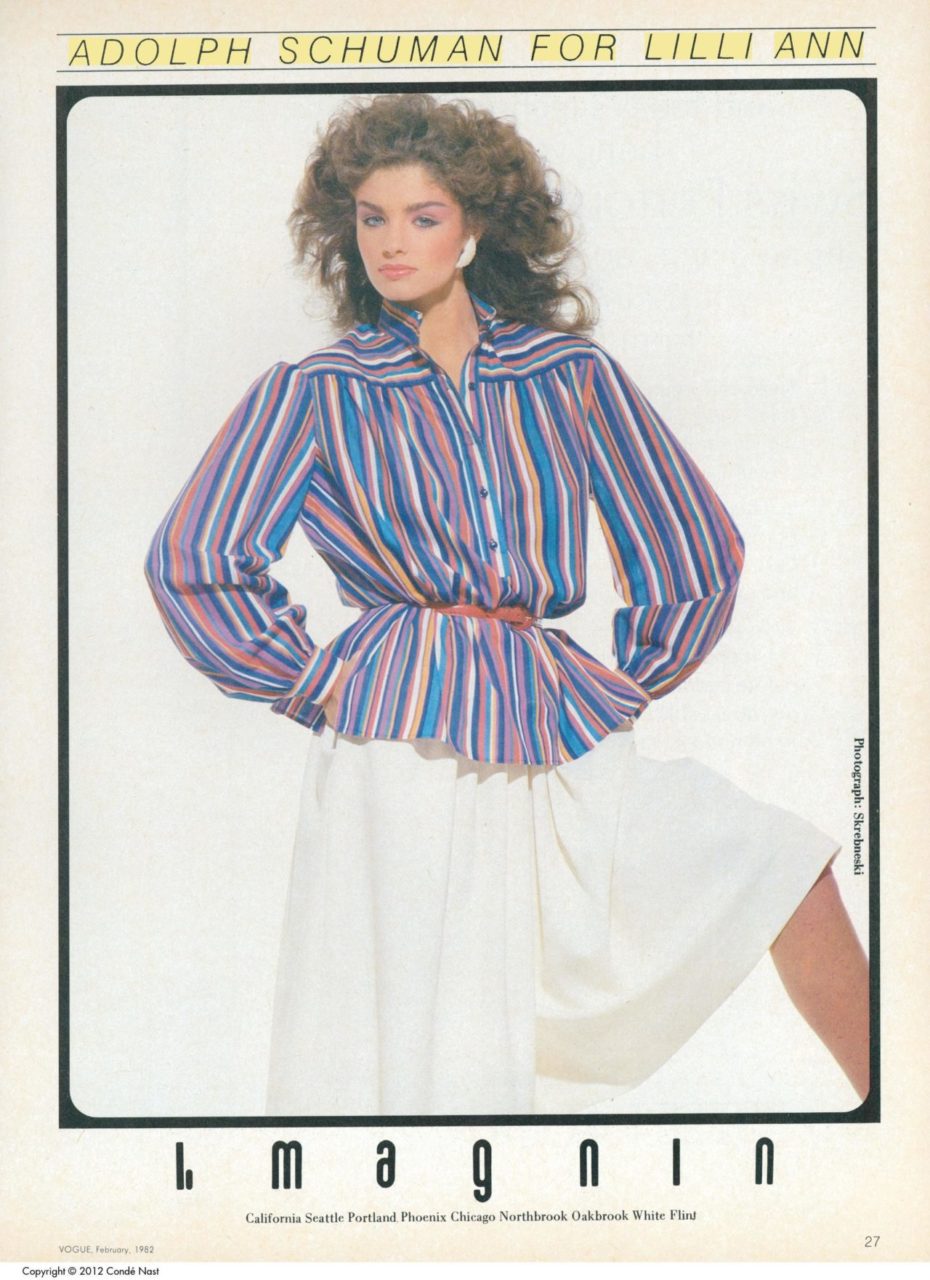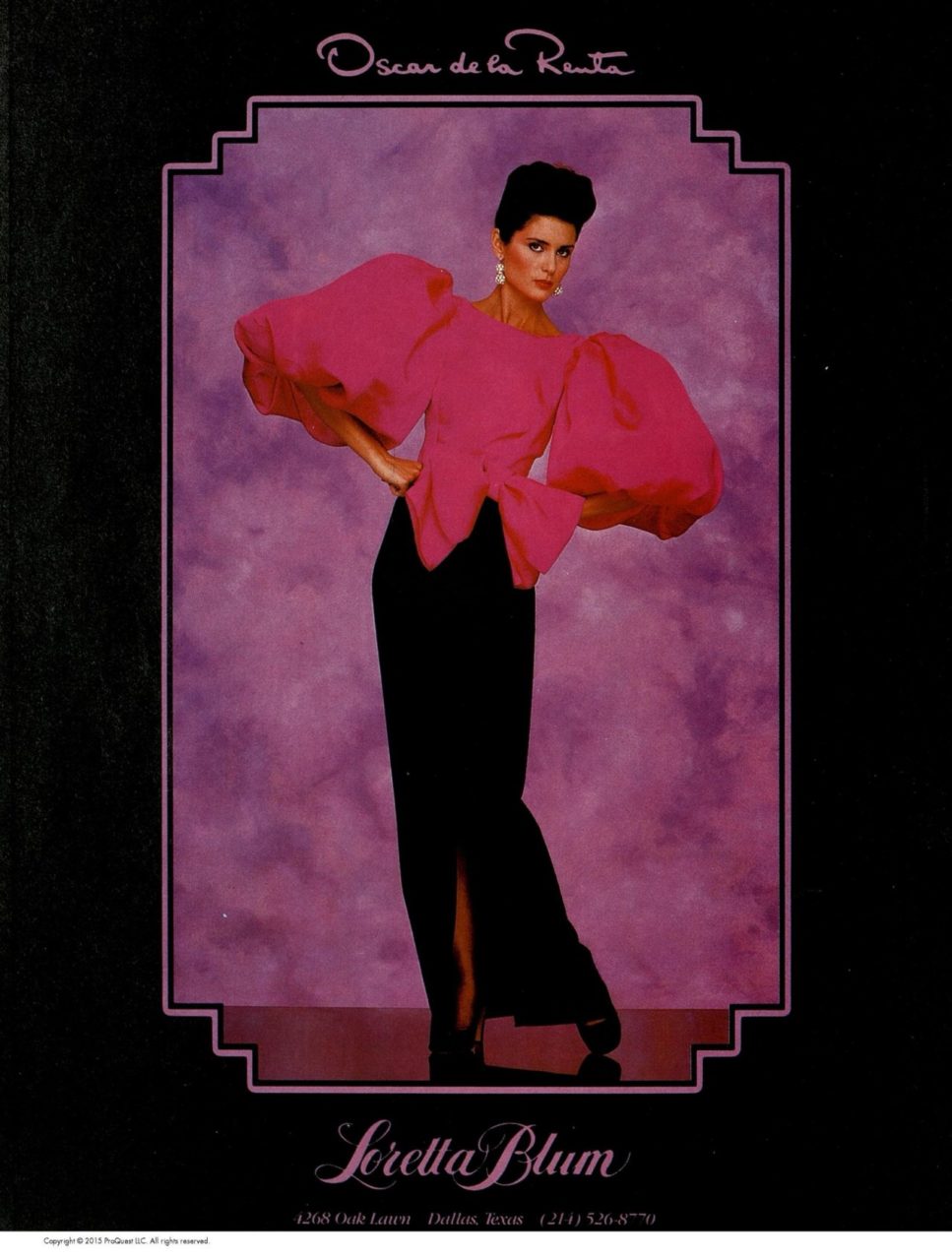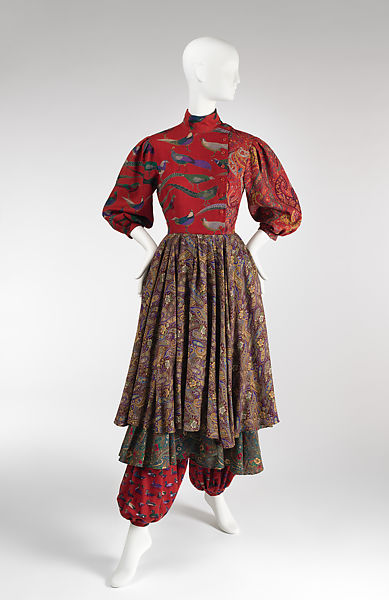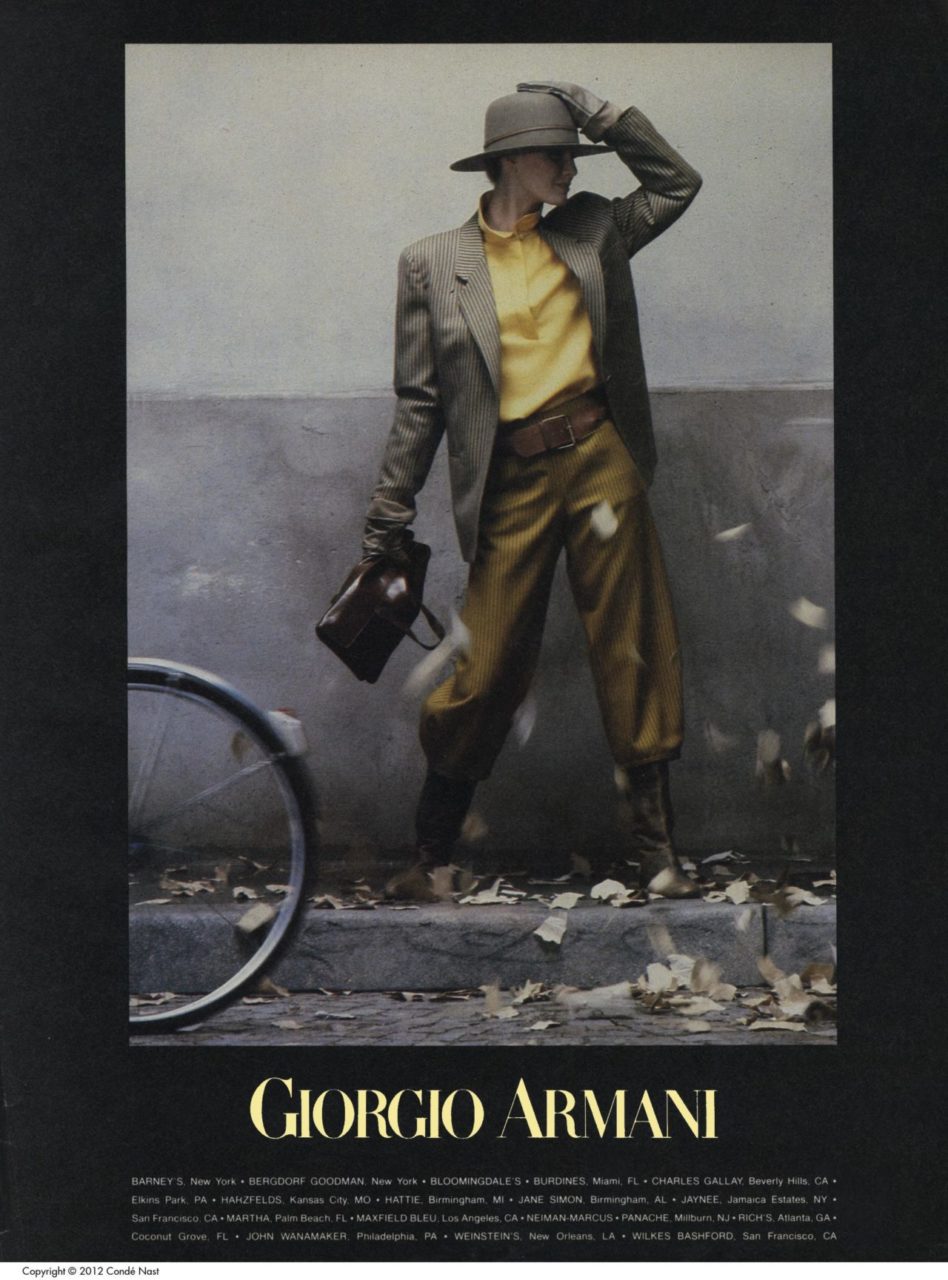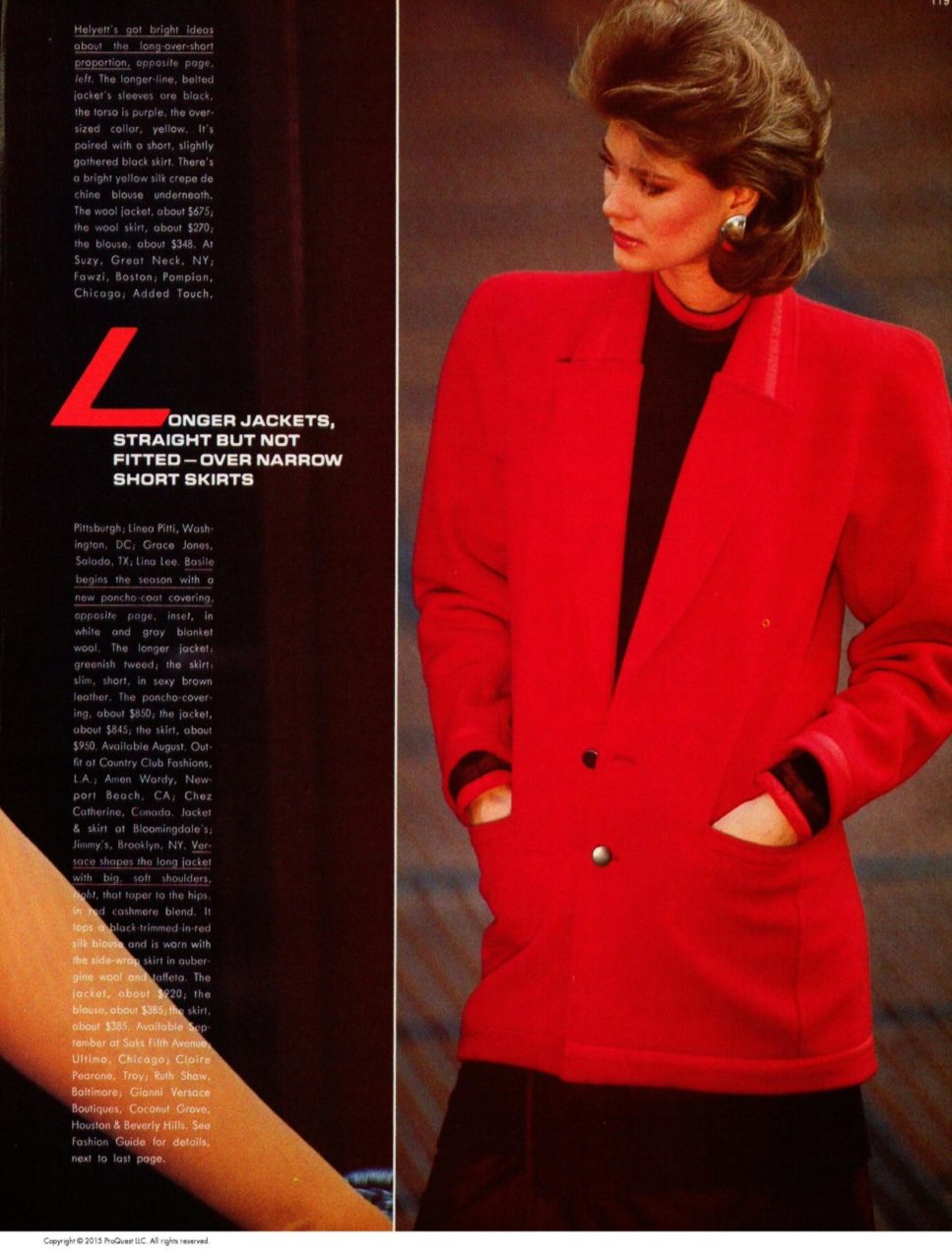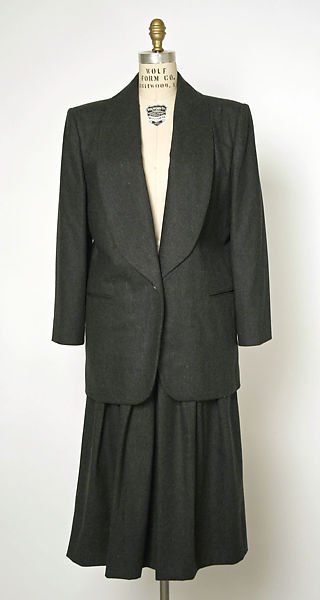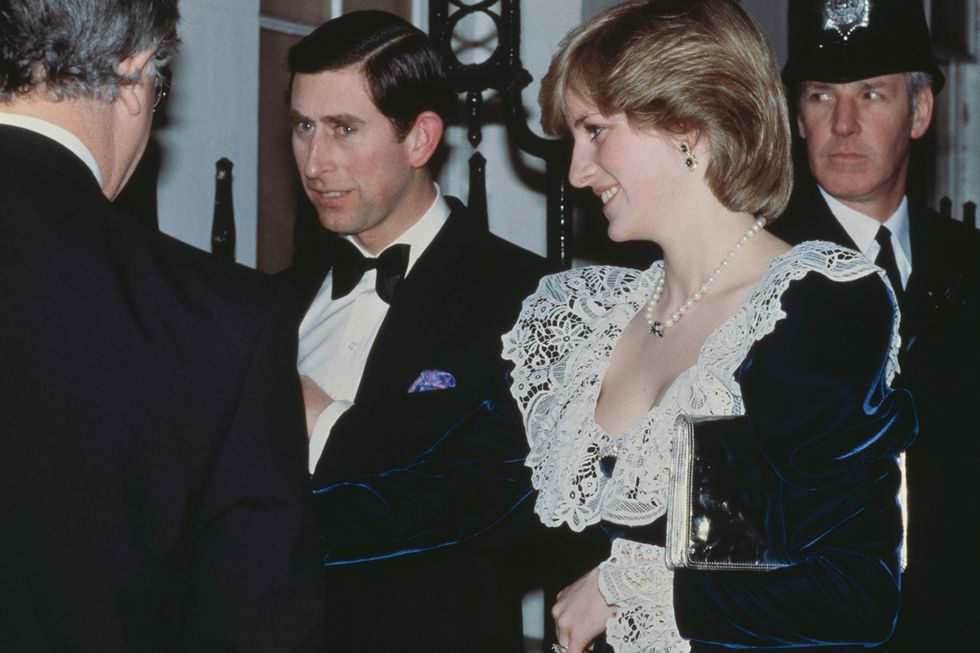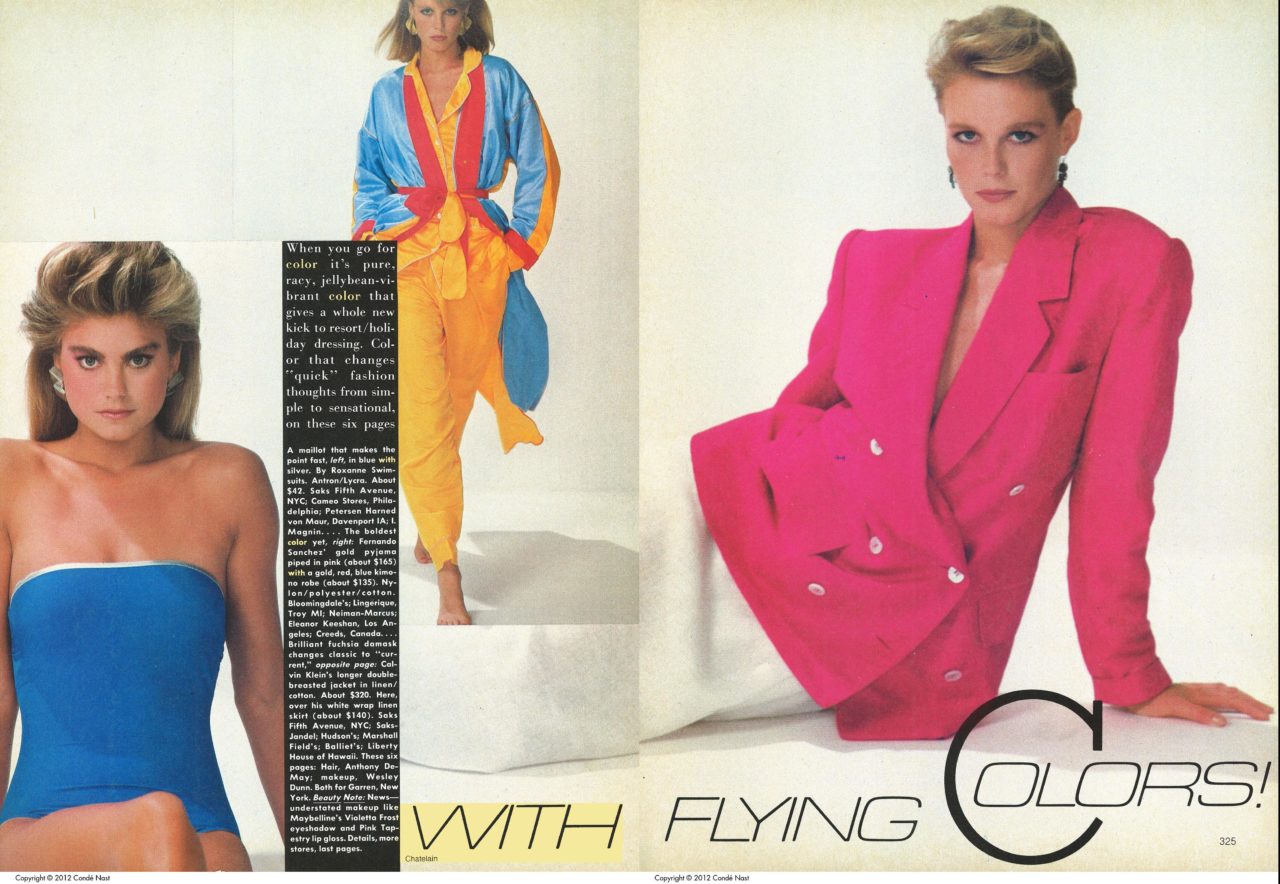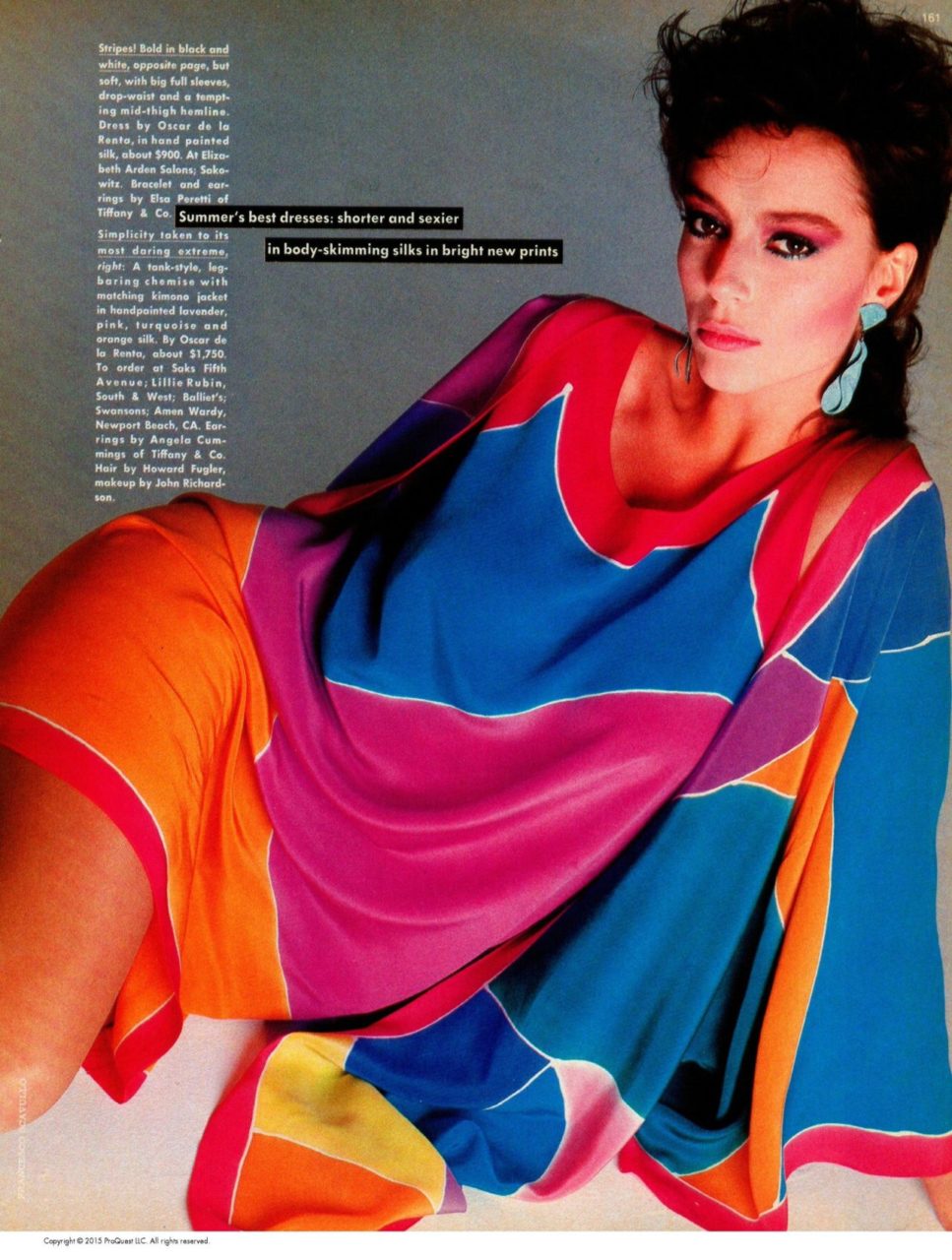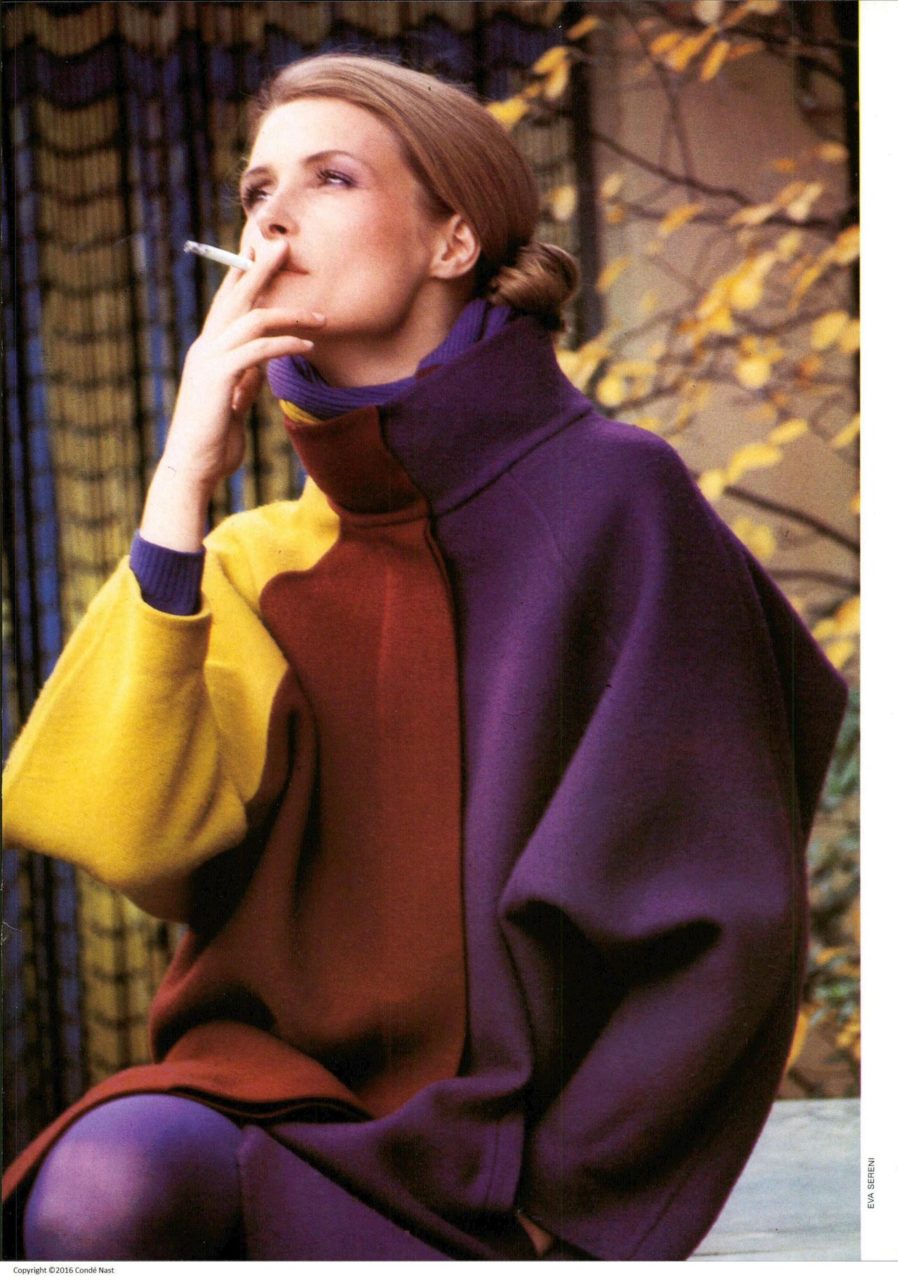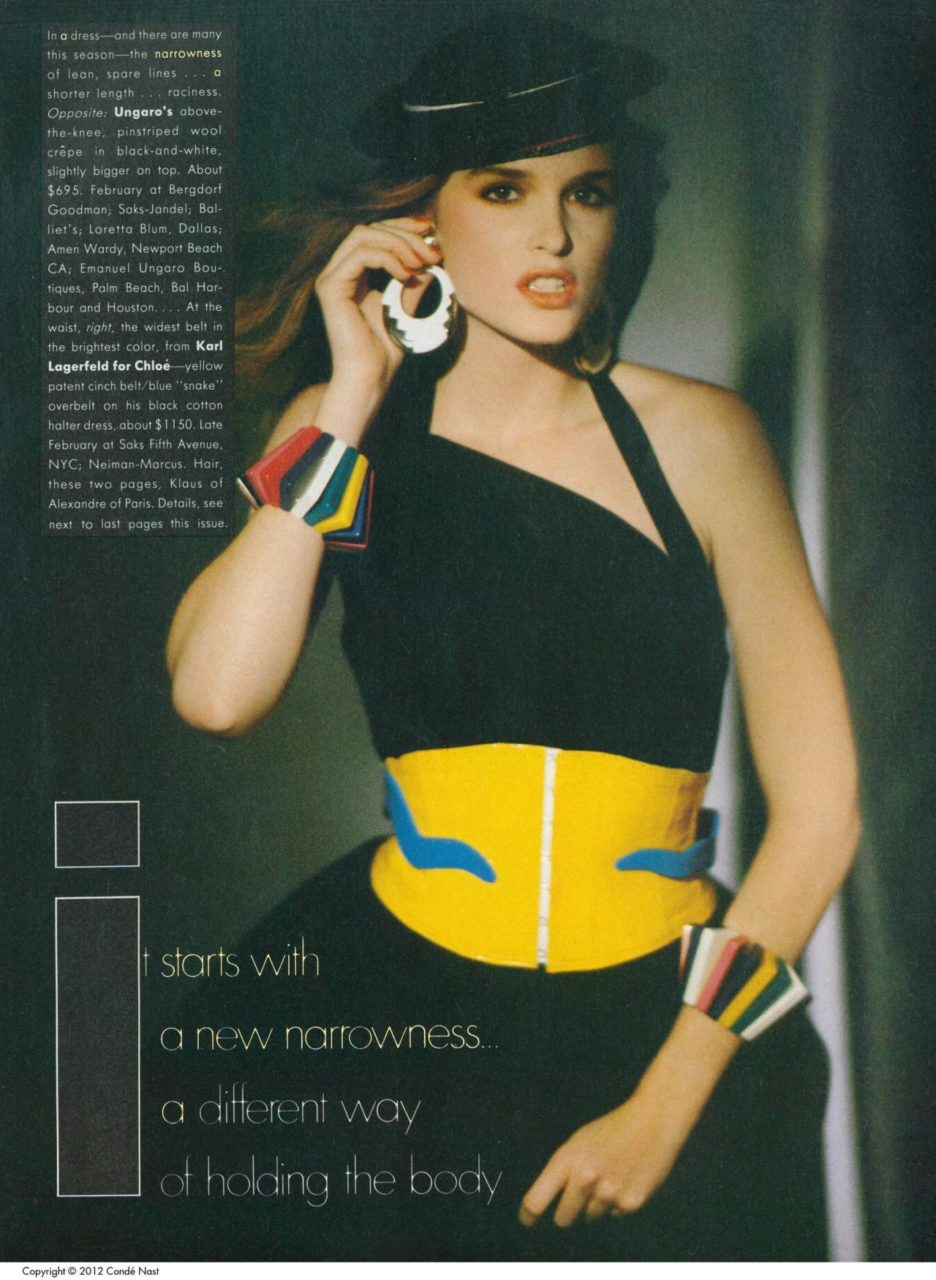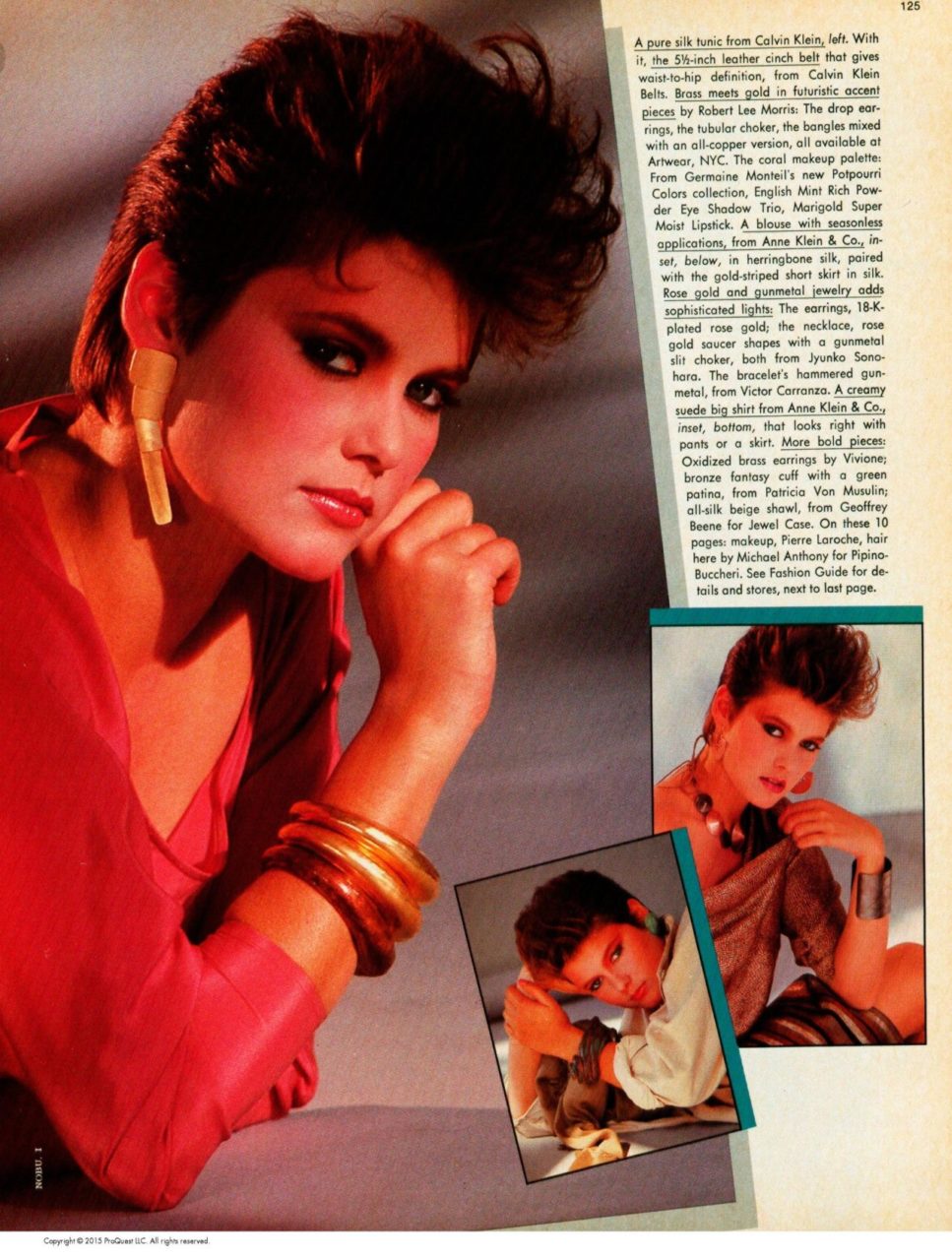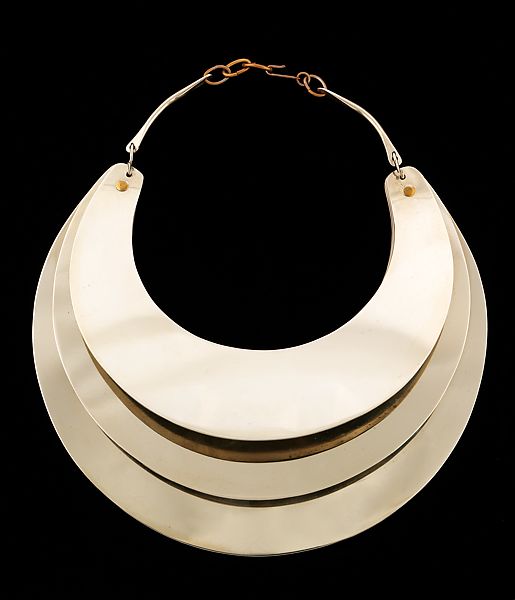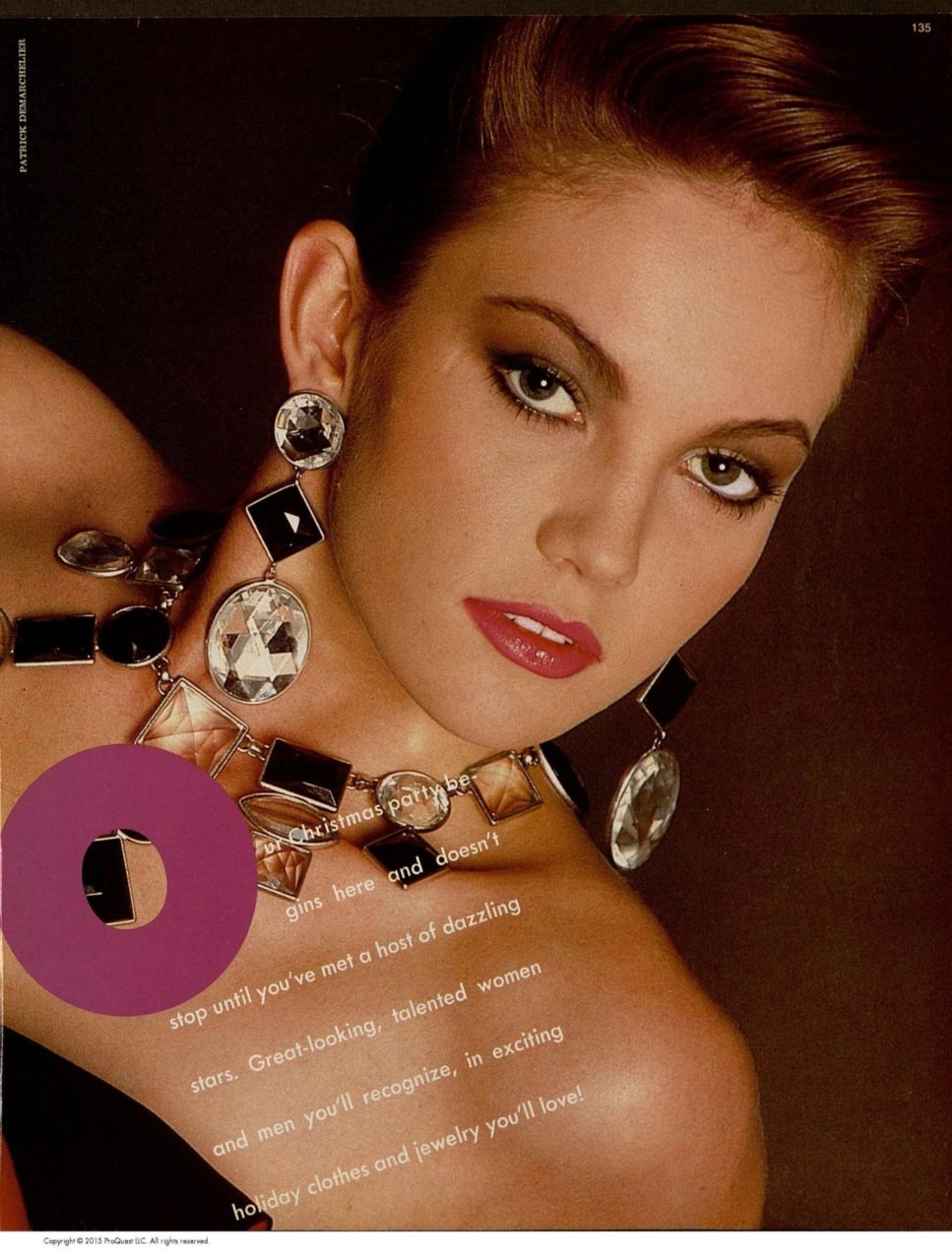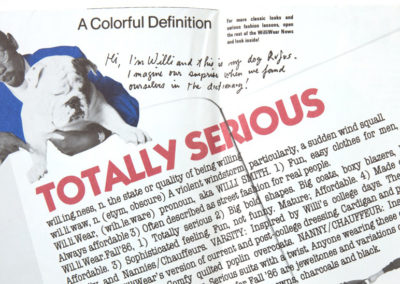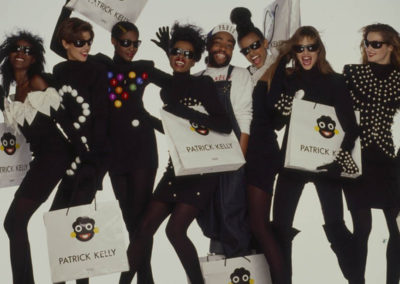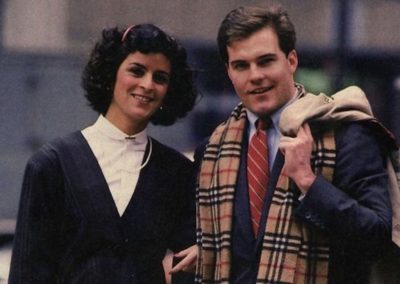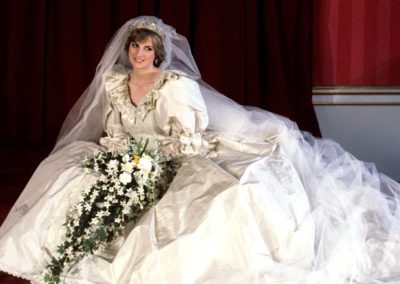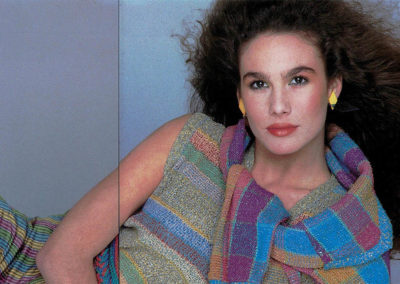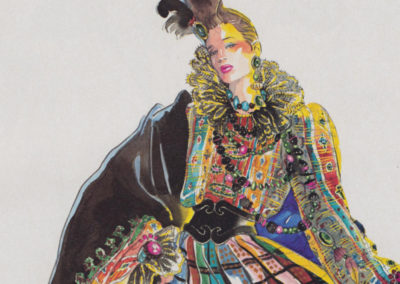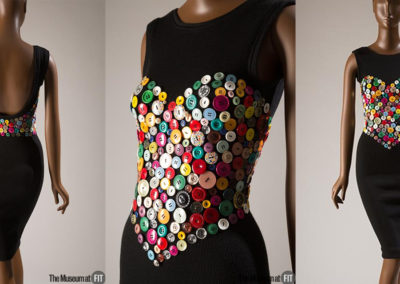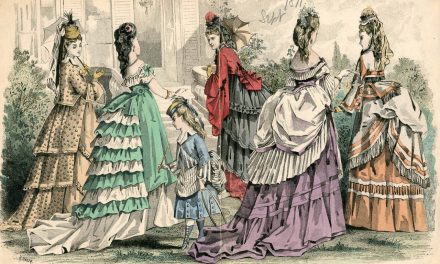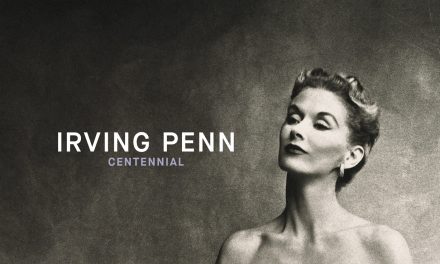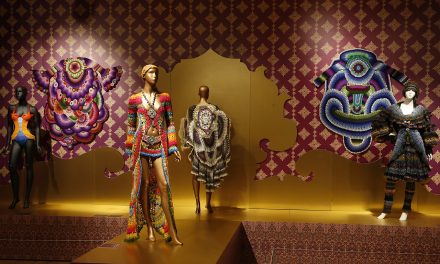OVERVIEW
1982 was a year filled with dramatic and bold fashions. The biggest trends of the year were statement patterns, exaggerated sleeves, broad power shoulders, vibrant colors, and oversized costume jewelry.
Womenswear
The year 1982 and the 80s, in general, was an electric time in fashion. A very common silhouette was an oversized blouse with a statement belt to achieve the desired figure. The contrast between a large voluminous sleeve and a tiny waist was very desirable. Women’s power suits were popular as they were for the entire decade of the eighties. All of these silhouettes were seen in fashion magazines in bright colors and exciting prints. The dress of the year by Margaret Howell, Nigel Preston, and Maxfield Parrish shows a rather timid use of these elements (Fig. 1).
Do stripes, polka dots, plaids, florals, and geometric shapes come together to create a unified ensemble? Typically not, but in 1982, anything goes. Head-to-toe patterned ensembles were often seen in the pages of the trendiest fashion magazines. This image may seem unsettling, but somehow the designers of the year made these dynamic patterns into some of the most coveted items to own. An example can be seen in an advertisement for Jack Mulqueen’s designs in Vogue from November 1982 (Fig. 2). These eye-catching ensembles were available for purchase in department stores such as Bergdorf Goodman’s for around $248. This trend was similarly seen in French design houses. In Dior’s fall/winter 1982 collection, designer Marc Bohan combined a burgundy floral pattern with stripes of blue, green, and yellow fabrics to create one dress (Fig. 3). The Italian brand Missoni capitalized on this trend in the eighties as well. Their use of various patterns can be seen in this advertisement from Vogue Italia‘s April 1982 issue (Fig. 4). Designers were inspired by many things to create such decorative prints. In discussing fabrics for Fall 1982, Women’s Wear Daily writes;
“Modern and classical art themes are the inspiration for printed American fabrics for fall, 1982. Works from Seurat, Van Gogh, Mondrian, and Monet are among the sources for the designs that include a sophisticated abstract brush-stroke paisley on polyester satin… Another directional trend is classified as Renaissance, featuring baroque and tapestry moods. A velveteen print from Miroglio Textiles, for example, features a border with diamonds, miniature leaves, and flowers on a paisley ground.” (24)
Many European design houses utilized statement patterns in their designs. Another popular designer of the year was Yves Saint Laurent, who was at the top of the industry (Golbin 607). An example of one of his designs is seen in Vogue Italia‘s March 1982 issue (Fig. 5). This dress also features the patterns on trend in 1982.
For sleeves in 1982, the more voluminous, the better. Tops of the year would commonly feature largely exaggerated balloon sleeves that added extra volume to a woman’s arms. Since the fashions of the year showcased an oversized sleeve, to accomplish the ideal female figure, designs would often be belted or tight around the waist. This strong juxtaposition between a voluminous sleeve and a tiny waist achieved a common ideal silhouette that can be found throughout fashion history. An example of this silhouette can be seen in an advertisement for Adolph Schuman’s designs in the pages of Vogue‘s February 1982 issue (Fig. 6). This not only features a desired shape of the year, but also the bright colors and exciting prints that were in fashion. Everyday women on the street could be seen in a design like this during the year. In a very over the top example, Oscar de la Renta, one of the most influential designers of the 80s (Butchart), incorporated this style into his designs. His use of exaggerated sleeves can be seen in this advertisement in November’s issue of Harper’s Bazaar (Fig. 7). This exceptional design features a classic bell sleeve that takes the trend to an even more over the top shape. Perry Ellis, an American ready-to-wear designer popular in the eighties, designed clothes with the year’s trends in mind. An example of this can be seen in this design where he features not only exaggerated sleeves but also a combination of statement patterns (Fig. 8).
Fig. 1 - Nigel Preston/Maxfield Parrish Margaret Howell (English, 1946-). Dress of the Year, 1982. Source: Fashion Museum Bath
Fig. 2 - Jack Mulqueen (American, 1943-1969). Vogue, November 1982 pg. 16. Source: Vogue Magazine
Fig. 3 - Marc Bohan for Dior (French, 1926-). Evening dress, fall/winter 1982-83. Source: The Metropolitan Museum of Art
Fig. 4 - Missoni (Italian, est. 1953). Vogue Italia, April 1982 pg. 94-95. Source: Vogue Italia Magazine
Fig. 5 - Yves Saint Laurent (French, 1936-2008). Vogue Italia, March 1982 pg. 39. Source: Vogue Italia Magazine
Fig. 6 - Adolph Schuman for Lilli Ann (American, 1907-1985). Vogue Magazine, February 1982 pg. 27. Source: Vogue Magazine
Fig. 7 - Oscar de la Renta (American, Dominican, 1932-2014). Harper's Bazaar, November 1982 pg. 156. Source: Harper's Bazaar Magazine
In the eighties, a new woman-dominated fashion: the powerful working woman. Menswear suiting became popular for the educated woman who valued her career and success. To create this powerful look, the body’s natural shape was not enough. These garments required shoulder pads to enhance the powerful silhouette of this woman. This newly popularized style of dress was inspired by the power that came with appearance. In Fashion: The Twentieth Century (2006), François Baudot discusses this concept:
“Appearance was allied to performance, which was of paramount importance to a generation of yuppies, or urban professionals. Their need to look the part related to a desire for power that, after twenty years of utopian dreaming, was a source of inspiration for the upwardly mobile.” (276)
It is clear why it became common for these women to dress in clothes typically reserved for men in the business world. The women of the year aspired for excellence and dominance in a male-dominated work environment. They wanted to be just as strong and powerful as the traditional male figures. In Fashions of a Decade. The 1980s (1990), Vicky Carnegy discusses power suiting, writing:
“The look produced by the designers in the early 1980s for this market (the Yuppies) was, essentially, based on the male silhouette. Wide shoulders were the key, emphasized with pads. For the day, the suit was essential for both the working man and woman. His was, typically, double-breasted with front-pleated trousers, creating a broad, powerful image. For her, the jacket was worn over a safe on or below-the-knee-length narrow skirt. The classic Armani jacket, hanging loosely from wide shoulders, disguised the waist and narrowed the hips, leaving hair, makeup and legs to proclaim femininity.” (32)
Fig. 8 - Perry Ellis (American, 1940-1986). Ensemble, fall/winter 1981-82. Source: The Metropolitan Museum of Art
Fig. 9 - Giorgio Armani (Italian, 1934-). Vogue, September 1982 pg. 159. Source: Vogue Magazine
Fig. 10 - Unknown. Harper's Bazaar, July 1982 pg. 119. Source: Harper's Bazaar Magazine
In 1982, Giorgio Armani capitalized on business by designing for this empowered woman. His classic suiting became very popular. An example of his designs can be seen in an advertisement in Vogue‘s September 1982 issue (Fig. 9). The professional suit coat the model is wearing most definitely features shoulder pads to create the structured silhouette. Another example of this jacket style can be seen in the fall designs covered in Harper’s Bazaar‘s July 1982 issue. This bright red jacket would be very fitting for a woman wanting to achieve this powerful silhouette (Fig. 10). Perry Ellis designed for this working woman as well. An example of one of his menswear designs can be seen here with a hard-edged shoulder (Fig. 11).
Shoulder pads were not only seen in suiting. It made an appearance throughout all women’s fashions. Harper’s Bazaar named a dress worn by Princess Diana as the top trend of 1982 (Fig. 12). This dress with a large, delicate lace collar was most definitely constructed with the use of shoulder pads to create the desired shape. Pierre Cardin, the Dé d’or [Golden Thimble] Award winner of 1982, included some outsized shoulder pads in his designs as well (Fig. 13). Women everywhere were rocking new padding on the shoulders.
Fig. 11 - Perry Ellis (American, 1940-1986). Suit, Early 1980s. Source: The Metropolitan Museum of Art
Fig. 12 - Princess Diana (English, 1961-1997). Harper's Bazaar - What Everyone Was Wearing the Year You Were Born, 1982 Trend of the Year. Source: Harper's Bazaar
Fig. 14 - Unknown. Vogue, December 1982 pg. 324-325. Source: Vogue Magazine
Fig. 13 - Pierre Cardin (French-Italian, 1922-). Ensemble, 1982. Source: Pierre Cardin Website
Fig. 15 - Oscar de la Renta (American, Dominican, 1932-2014). Harper's Bazaar, May 1982 pg. 161. Source: Harper's Bazaar Magazine
Fig. 16 - Unknown. Vogue Italia, January 1982 pg. 281. Source: Vogue Italia Magazine
Fig. 17 - Karl Lagerfeld (German, 1933-2019). Vogue, January 1982 pg. 137. Source: Vogue Magazine
The brightest colors dominated fashion in 1982. The decade overall is known for being a bright and flashy decade celebrating wealth and extravagance. The fashions of the year were certainly not shy when it came to the combination of vibrant colors. A spread in the December 1982 issue of Vogue magazine discusses this trend (Fig. 14). Seen here are the brightest shades of blue, red, yellow, and pink. The journalist writes, “When you go for color, it’s pure, racy, jellybean-vibrant color that gives a whole new kick to resort/holiday dressing.” (324). This trend was very accessible and it was common to see these shades amongst the fashionistas of ’82. These colors were often seen styled together, but some designs incorporated them all into one piece. An example of this can be actress Rachel Ward in an article in the May 1982 issue of Harper’s Bazaar. Seen here, Ward is wearing an electric silk dress designed by Oscar de la Renta (Fig. 15). Not only was this a trend seen in the pages of American magazines, but it was seen the pages of the high fashion European magazines. Bright fashions covered the pages of Vogue Italia as seen in their January issue of 1982 (Fig. 16). This ensemble featuring a selection of several popping colors is a perfect example of the fashions popular of 1982.
The fashions of 1982 were exciting and exaggerated. That did not only show on the clothing; accessories were vital to complete the ensemble. Bold statement jewelry pieces were a must-have to complete any look. Bracelets, necklaces, and earrings of all kinds were chunky and oversized. These pieces can be seen at the very start of the year in the January pages of Vogue. The model is styled with chunky bracelets featuring vibrant colors, large earrings, and an over-the-top bright yellow belt designed by Karl Lagerfeld (Fig. 17). In an article in January 1982’s issue of Harper’s Bazaar, a journalist discusses the accessories of the year writing:
“Today’s best dressing calls for a totally new perspective on pieces – everything from a slippery charmeuse tunic top or soft suede shirt-jacket to a wide hip-belt or dramatic earring can now be called accessory. They are the texture, color accents that make a look.” (125)
Seen here from the spread are models showcasing examples of the oversized jewelry pieces (Fig. 18). March’s Harper’s Bazaar issue covered cuffs specifically writing, “Today’s best-looking accessories are strong, bold scale pieces in brass. Though quite obviously metal, there’s nothing hard-edged or metallic about spring’s magnificent cuffs, wide bangles and abstract earrings.” (217). An excellent example of the metalwork done in 1982 can be seen here in Tess Sholom’s The Joy Collar designed for Bill Blass’s collection (Fig. 19). In reflecting on the trends of 1982, Daniel James Cole and Nancy Deihl write in The History of Modern Fashion (2015):
“Jewelry was often large, or worn in multiples. A pronounced historic influence was seen in jewelry design.” (355).
This trend in jewelry was seen year-round. In December’s Harper’s Bazaar, these extravagant costume jewels designed by Isaac Manevitz were seen on the young actress, Diane Lane (Fig. 20). Pieces like this were sure to make a statement amongst the already bold fashions of the eighties.
Fig. 18 - Robert Lee Morris (German, 1947-). Harper's Bazaar, January 1982 pg. 125. Source: Harper's Bazaar Magazine
Fig. 19 - Tess Sholom for Bill Blass (American, 1933-1989). The Joy Collar, fall/winter 1982. Source: The Metropolitan Museum of Art
Fig. 20 - Isaac Manevitz (Egyptian). Harper's Bazaar, December 1982 pg. 135. Source: Harper's Bazaar Magazine
References:
- Baudot, François. Fashion: The Twentieth Century. Rev. ed. New York: Universe, 2006.
- Butchart, Amber Jane. “Oscar De la Renta.” In Fashion Photography Archive. London: Bloomsbury, 2015. http://dx.doi.org/10.5040/9781474260428-FPA046.
- Carnegy, Vicky. Fashions of a Decade. The 1980s. New York: Facts on File, 1990.
- Cole, Daniel James, and Nancy Deihl. The History of Modern Fashion from 1850. London: Laurence King Publishing, 2015.
- “Fabrics: Painterly Prints.” WWD (Feb 26, 1982): 24. https://libproxy.fitsuny.edu:2818/docview/1445535636?accountid=27253.
- “Fashion: With Flying Colors!” Vogue (Dec 1, 1982): 324-324, 325, 326, 327, 328, 329. https://libproxy.fitsuny.edu:2818/docview/904307847?accountid=27253.
- Golbin, Pamela. “Saint Laurent, Yves.” In The Berg Companion to Fashion, edited by Valerie Steele. Oxford: Bloomsbury Academic, 2010. http://dx.doi.org/10.5040/9781474264716.0013442.
- “Soft Sensations: In Cuffs Now!” Harper’s Bazaar (March 1982): 216-229. https://libproxy.fitsuny.edu:2818/docview/1881115863?accountid=27253.
- “What Everyone Was Wearing the Year You Were Born.” Harper’s Bazaar, April 15, 2019. https://www.harpersbazaar.com/fashion/trends/g15895481/fashion-year-born/.
- “The New ACCESSORIES ATTITUDE.” Harper’s Bazaar (January 1982): 124-133. https://libproxy.fitsuny.edu:2818/docview/1735379259?accountid=27253.
Historical Context
Wikipedia: 1982
COTY Award winner: Adri
Dé d’or [Golden Thimble] Award winner: Pierre Cardin
Academy Award for Best Picture: Gandhi
Academy Award for Best Costume Design: Gandhi (Bhanu Athaiya and John Mollo)
Events:
- The first CD player was sold in Japan.
- Time magazine’s Man of the Year is given for the first time to a non-human, the computer.
- The first emoticons were posted by Scott Fahlman on September 19th.
- Michael Jackson releases his sixth studio album, Thriller, in the United States, which will go on to be the greatest selling album of all time at 110 million units sold worldwide on November 30th.
Primary/Period Sources
Resources for Fashion History Research
To discover primary/period sources, explore the categories below.
Have a primary source to suggest? Or a newly digitized periodical/book to announce? Contact us!
Periodicals (Digitized)
Filmography
Secondary Sources
Also see the 20th-century overview page for more research sources... or browse our Zotero library.

